
by Charles Bonniwell | Dec 15, 2023 | Editorials
Editorial —


Denver’s new Mayor Mike Johnston, upon assuming office earlier this year, declared that his top priority was housing the homeless. It is not clear whether the politically correct term is “homeless” or the newer “unhoused,” but either appears allowable for the time being. On Johnston’s first day in office, he declared a state of emergency around homelessness and prioritized housing 1,000 homeless people in his first year as mayor. He had learned, as so many politicians had under COVID-19, that you can do things under an emergency that you could never get away with in “normal” times.
Not to let grass grow under his feet he went on a tour of the city’s 74 neighborhoods hoping to find 200 public plots to place “tiny home” communities where people experiencing homelessness could be housed. As he said, “This is what we think is the most important crisis the city is facing.” But with only a month to go only about 250 people have boarded under the program so far.
It may come as a surprise to some newcomers to Denver that housing the homeless has not always been the top priority of a city with now over 711,000 people. “The greatest good for the greatest number” is definitely not a guiding principle of the new progressive Johnston administration.
Of course, there have always been unhoused people in Denver since its founding in 1858, but the so-called homelessness crisis did not reach full public awareness until the 1980s with the dropping of certain housing programs by the Reagan administration and the widespread deinstitutionalization of the mentally challenged. Even then the crisis did not seem so overwhelming that all other city businesses had to grind to a halt.
Denver’s first progressive mayor, Frederico Peña, convened a taskforce in 1984 which led to city funding for a non-profit organization called the “Coalition for the Homeless.” John Parvensky, who would become the head of the organization for 37 years, joined in 1985. It had at the time a $100,000 budget and a staff of six. Parvensky has been deemed one the most successful modern Denver entrepreneurs growing his homelessness business to 750 employees and 2,000 volunteers and a budget of over $126,000,000 when he retired.
He was able to do this all while increasing the number of homeless to a little over 3,600 when he left. Following the footsteps of Parvensky, an energized younger staff at the Coalition headed by the new President and CEO Britta Fisher, have managed to grow homelessness in Denver in a single year by an impressive 31.7% to just under 4,000. Even more impressive is her growth in homelessness for the first timers by 120.4%. Even the late Bernie Madoff would have had to give a tip of the hat to that achievement.
Luckily at the right time, the homeless have a true advocate in the city’s new mayor, Mike Johnston. Not since Mayor John Hickenlooper and his “10 Year Plan to End Homelessness” have the homeless had such a champion. But even John Hickenlooper was not willing to suspend all work on any other of the city’s concerns in the name of growing the all-important homeless segment of the population. As Johnston stated, “We took the oath yesterday to commit on taking on this problem.” The new mayor correctly understood that the city could not rely on existing Denverites facing hard times to sufficiently increase the homeless. No, if homelessness was going to continue to be a growth industry in Denver, we needed to attract homeless from all across the country. What better way than to guarantee any person coming to Denver a home as the mayor did. Moreover, Mayor Johnston has promised “funding for wrap around services and it will come from the existing Homelessness Resolution Fund.” In addition, money forecasts will come from Proposition 123, the “Colorado Affordable Housing Financing Fund” which is expected to bring in $300,000,000 annually.
Mayor Johnston sagaciously understands that Denver is at a competitive disadvantage in attracting the homeless due to, at times, brutal winters in Colorado. Thus, we must look abroad for assistance in growing homelessness in Denver. Foreword thinking Mayor Wellington Webb back in 1998 declared Denver to be a “sanctuary city” for illegal immigrants with Executive Order 116. Mayor Hancock cleared any ambiguity over the executive order when he declared that Denver welcomed the “sanctuary city” designation. This allows the “Queen City of the Plains” to partner in a bipartisan manner with Democrat led cities in Texas, like El Paso, and Republican Governor Greg Abbot’s Operation Lone Star to bus homeless illegal immigrants from all over the world right to our doorsteps.
True, we need to share the bounty with other sanctuary cities like New York City, Chicago, and Los Angeles, but there are tens of thousands pouring over the border every day. President Biden and Secretary of Homeland Security Mayorkas have promised to keep the border open as long as humanely possible.
Denver, in welcoming thousands of new homeless customers from across the country, and the world, will dwarf the 1,000 people that Johnston claims he will be housing this year. We have a modest proposition that Denver needs to require the Coalition of the Homeless to go public on the New York Stock Exchange. While homelessness has been a major growth industry in Denver over the last 40 years, its salad days are far from over with Mayor Johnston at the helm. That way the individual investors in Denver could join Mayor Johnston in celebrating the New Year and look for positive returns for years to come.
— Editorial Board

by Charles Bonniwell | Nov 16, 2023 | Editorials
 At one time not so long ago, everyone loved bicyclists. What is there not to love? The vast majority of people have ridden a bike some time in their lives. Bicycling is great for your health, it lessens automobile traffic, and is helpful to the environment as a whole. But as Eric Hoffer surmised, every cause starts as a movement, becomes a business, and finally a racket. Even many bicyclists intensely dislike the bicycle lobby in Denver, as evidenced by the many communications this publication received on last month’s lead story: “7th and Williams Fiasco.”
At one time not so long ago, everyone loved bicyclists. What is there not to love? The vast majority of people have ridden a bike some time in their lives. Bicycling is great for your health, it lessens automobile traffic, and is helpful to the environment as a whole. But as Eric Hoffer surmised, every cause starts as a movement, becomes a business, and finally a racket. Even many bicyclists intensely dislike the bicycle lobby in Denver, as evidenced by the many communications this publication received on last month’s lead story: “7th and Williams Fiasco.”
Developers use the bicycle lobby to argue that they should not have to provide adequate parking for their high-density apartment buildings. Denver’s Department of Transportation and Infrastructure (DOTI) has been captured by the bicyclist lobby and is busily screwing up streets across the city with ridiculous and ugly plastic bollards, roundabouts, and striping all in the name of “bicycle safety.”
Whether it’s at Williams and 7th, Broadway, or Marion Parkway, DOTI’s work is reviled by residents, businesses, pedestrians, and bicyclists, and just about everyone else with the exception of the bicycle lobby and tone-deaf politicians like District 5 Councilwoman Amanda Sawyer. Moreover, this is just the beginning. DOTI has many other so-called “bicycle safety” projects on its books throughout the city.
The worst part of it is, as letters to this paper demonstrate, that DOTI’s monstrosities do not provide bike safety, but just the opposite for everyone involved, including bicyclists. Accidents are piling up along the streets that DOTI has jerry-rigged, and in particular, where it has installed roundabouts on streets not designed for them, with trucks, buses, delivery vans, and other larger vehicles having to careen around them.
The intersection of 7th and Williams alone has seen four accidents between September 25 and October 6, bringing the total amount of accidents since the installation of these roundabouts to nine, as reported to the Chronicle by Kitty Koch, Denver resident.
But the baleful influence of the bicycle lobby is not limited to the actual streets of Denver. Last fall, Ordinance 307 was pushed by the bicycle lobby and was narrowly passed. This ordinance imposes fees on Denver homeowners from $110 to $1,000 per year for sidewalk repairs (see “Bicycle Lobby Peddles Tax That Forces Property Owners To Fix City Sidewalks”, January 2023 edition of the Chronicle). Voters who live in apartment buildings are not directly affected, but homeowners are. They have taken their outrage to Denver’s City Council, which has been delaying the implementation of the now highly unpopular fees, but the day of reckoning is coming.
Undoubtedly, the bicycle lobby is searching for other opportunities to make the lives of Denverites worse and more costly as that lobby is a monster that must be fed. What can you do about it? Well, supporting the expected recall effort of Councilwoman Amanda Sawyer, who is a pitchwoman for the bicycle lobby, would be a positive step. Electing someone who returns calls and cares about his/her constituents and not just pressure groups is never a bad idea.
— Editorial Board

by Charles Bonniwell | Oct 20, 2023 | Editorials
The election to replace Auon’tai Anderson as the at-large Board member for Denver Public Schools (“DPS”) will occur on November 7, 2023. Fortunately, almost anyone in the world would be better than Tay Anderson, who became best known for harassing underage girls and setting up grifting GoFundMe get rich schemes. He was the one leading the charge to get rid of police resource officers that got a teacher killed, not that he cared.
It is amazing that anyone would want to run for the thankless non-paying position. Moreover, the Denver School Board is itself a morass of petty, bickering, backstabbing individuals that spend most of their time fighting about the black/brown divide and little about the scandalous performance of Denver Public School students after the closure of the schools because of COVID-19. Those closures were prolonged by the teachers’ unions across the country. The one silver lining to those closures was parents got to see what the schools were in fact teaching and many didn’t like what they saw.
Less than half of DPS students can now read, write, add, and subtract at grade school level and it is getting worse. The longer your child spends at DPS the worse it gets. At one time the business community actually cared about DPS board races, but have abandoned the schools, leaving the field to the teachers’ union (the Denver Classroom Teachers Association) with expected disastrous results.
For this election you actually have a choice. The teachers’ union has endorsed former mayoral candidate and ex-CEO of the now bankrupt Tattered Cover Bookstores Kwame Spear. The teachers’ union has endorsed and gotten elected far worse individuals (see present DPS Board).
Spear is a graduate of DPS, undergrad degree from Columbia, law degree from Yale, and business degree from Harvard. He is probably way overqualified to be on a board of misfits and malcontents. He wants to up teacher pay, paid by a tax hike through a citywide ballot measure. He also wants to boost teachers’ healthcare and parental leave benefits. Moreover, he is for subsidized teacher housing with a down payment support program, and 2,000 units of subsidized housing built on city-owned land. He declares that “the best way to support our students is to support our educators.” No wonder the teachers’ union loves the guy.
But we don’t agree that simply pouring money and benefits to teachers is the best way to help students. He doesn’t demand any increased accountability or increased standards from those same teachers. In the end he will likely simply enrich teachers while the students will continue getting the same deficient education.
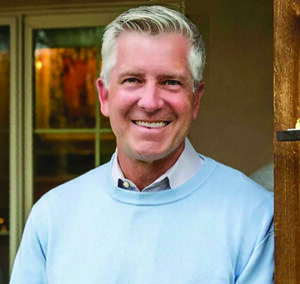
John Youngquist
The other major candidate is John Youngquist. He is the former principal of East High School and parent of two East High students. He also served as the area superintendent of
36 schools in Northwest Denver, and has been the president of a consulting firm for school principals.
He decided to run after watching the present board and the superintendent fail to address safety threats and concerns on campuses across the city. He has been endorsed by Denver Family Action, a charter school supporter. Notwithstanding that teachers’ unions believe that schools are there to provide a living for teachers and bureaucrats, education is really about the students and their education. The best way to provide a great education is giving students and their parents choices for schools and letting them determine what is best for them. It creates automatic accountability. Luckily Denver has begun a strong charter and Magnet school program that needs to be expanded and grown upon, and it’s clear Youngquist will do that as well as provide a safe learning environment in all public schools. He has the background to know what works in Denver schools and what does not.
The third candidate is Brittni Johnson, a licensed massage therapist who is now unemployed due to a car accident. She has raised little money and has done little campaigning for the job. She has been endorsed by a plethora of progressive groups. She is the one that would probably fit in well with the other present Board members.
If you’re a teacher and want to vote your pocketbook, then you would want to go with Kwame Spear, but for everyone else, John Youngquist appears the strongest candidate, and we strongly endorse him.
— Editorial Board
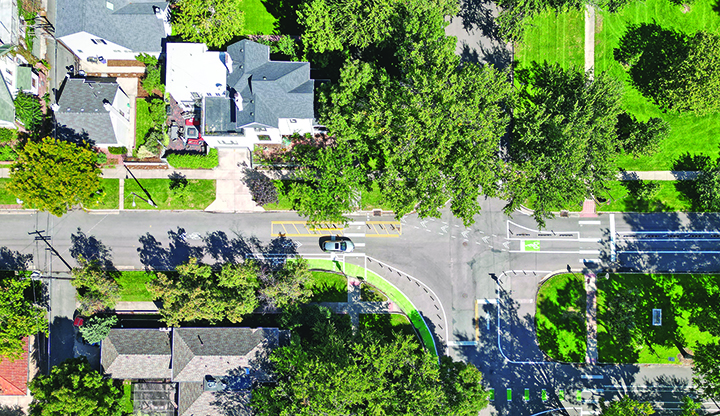
by Charles Bonniwell | Sep 26, 2023 | Main Articles
Neighborhoods In Revolt / Cries For Recall Of Sawyer
by Charles C. Bonniwell

Aerial View: The project by DOTI at the intersection of 7th Avenue created ugly and highly dangerous conditions for automobiles, bicyclists, and pedestrians, and has residents up in arms.
The redesign of the intersection at 7th and Williams was supposed to be a neighborhood friendly effort to make it more safe and pleasant for non-automobile traffic in one of Denver’s more pleasant areas near Cheesman Park. Instead, it’s become a Rube Goldberg contraption endangering bicyclists, automobiles, pedestrians, and even children.
Instead of admitting its errors, Denver’s Department of Transportation (DOTI) and the area’s City Councilwoman Amanda Sawyer have dug in their heels and refused to remedy a highly dangerous situation exposing how government seem to be no longer responsive to its citizenry.
The project was part of DOTI’s Neighborhood Bikeway program which was supposed to improve safety for people riding bikes on city streets. Instead, according to Kitty Koch, a 7th Avenue Historic District resident, “these measures are unnecessary, unsafe, and negatively impact the beauty, character, and integrity of this historic neighborhood.”
The Intersection
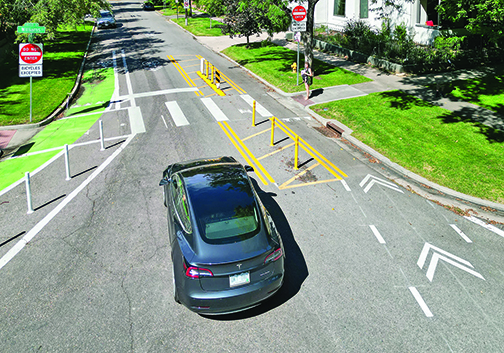
A confused motorist crosses 7th Avenue and Williams Street, heading West through a Do Not Enter sign, and endangers the woman with her baby on the right.
The intersection at 7th Avenue and Williams Street is an asymmetrical four way stop where the 7th Avenue Parkway median begins. Heading east on 7th Avenue, a traveler needed to simply to move over to the south side of the median. This was not deemed a problem until DOTI intervened. It constructed a kaleidoscope of colored signs, bike lane bollards (110 in this intersection alone), street markings, and caution bumps. Bicyclists, pedestrians, and automobiles are directed every which way, sometimes into oncoming traffic.
In just standing at the intersection for an hour this reporter observed over a dozen unintentional traffic violations. Bicyclists
are confused on where to go and pedestrians are unsure where to walk. When DOTI was alerted to the dangers, it refused to make any significant changes declaring in Orwellian fashion everything they did was in the name of “safety.” The minor changes that were made have made the situation worse.
The Strange Roundabouts
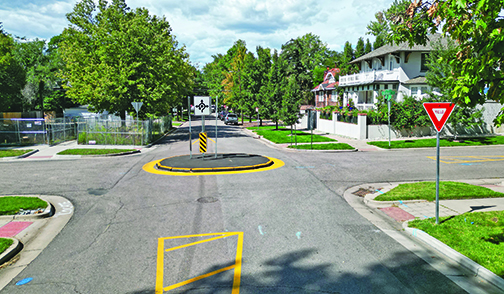
Strange Roundabouts: DOTI constructed three so-called “traffic calming” roundabouts on a narrow two-way street which fire trucks, garbage trucks, and other large vehicles have extreme difficulty navigating.
Heading east on 7th Avenue from the Country Club area there are a series of three strange roundabouts. Roundabouts were first designed in Europe to help with the flow of traffic but they require space to work. On 7th Avenue DOTI built three of them on a narrow two-way street as a “traffic calming” device. But garbage trucks, fire trucks, and other larger vehicles get stuck trying to get through the intersection. Resident Natalia Ballinger indicates that there have been at least four accidents at the 7th and Gilpin intersection within a span of six weeks. There is an informal moratorium on these types of roundabouts due to criticism from the Denver Fire Department but the 7th Avenue roundabouts remain.
The Rigged Meeting
The physical work on the project in April of this year came without the city informing the 7th Avenue Neighborhood Association of the project but notifying all other uninvolved neighborhood associations. The 7th Avenue area residents only learned about it belatedly from the Capital Hill United Neighbors Association. Residents do not believe that was simply an interferant mistake by DOTI.
“They didn’t say anything to the neighborhood about this,” said Rob Brown, a cyclist and a resident in the area. “This was something that was done to us and not with us. I think you would find everybody in the neighborhood is incredibly happy to promote safety in this corridor.” As more and more residents became upset, calls were placed to Amanda Sawyer, District 5 Councilwoman, to intercede on their behalf with DOTI which was ignoring all their complaints.

Concerned Citizens: Left to right, Rob Brown, Larry DiPasquale, and Kitty Koch are three of the many residents of the 7th Avenue Parkway area that are outraged at the actions of DOTI and District 5 Councilperson Amanda Sawyer.
On July 20, 2023, she finally responded and agreed to a neighborhood meeting but two hours before it was to occur Sawyer changed it to a webinar with a panel that included herself, Sawyer’s aides, and Nick Williams, the Deputy Manager of Internal and External Affairs, being the only ones who could talk. “They were the only ones able to speak,” said Koch. “Everyone else was a call in. It was clearly staged in my opinion because they did not accept our questions [50-60 questions].”
According to those involved, which included over 180 citizens, the calls were screened so that only the questions from a small number of people who were in favor of the project were allowed.
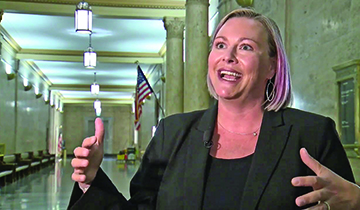
Recall Candidate: District 5 Councilperson Amanda Sawyer’s actions regarding 7th and Williams have so outraged residents that petitions are being drawn up and funds raised for her eventual recall.
Sawyer originally got into office as a neighborhood advocate against high density apartment projects in single family neighborhoods. She was a graduate of the scandal plagued Emerge Colorado program to get Democratic women elected. The group was dissolved by Emerge America under claims of fraudulent mismanagement. Sawyer became known in the city for her haughty and contemptuous attitude to the mayor’s staff and others she comes in contact with, and she even threatened to shut down road projects in the city over a dispute with a city employee.
After the rigged webinar meeting Sawyer stopped taking calls from individuals she deemed not approving of the 7th and Williams fiasco. Rob Brown indicates that he called her seven times and never received a return call. He noted: “The reason I am here now is because I am a cyclist. I know the city is trying to promote safety. I just don’t think they got it anywhere close to right.” He went on to note: “If they want to elevate the safety of this intersection, I think they need to go back to the drawing board. As a cyclist, I consider this intersection to be dangerous.”
Natalie Ballinger agrees: “We’re all thrilled to have a bikeway. This was such an opportunity for them [the City of Denver] to reach out to the people who live here to get their input and collaboration and to build community. It is almost a textbook example of how not to roll out a bikeway. “
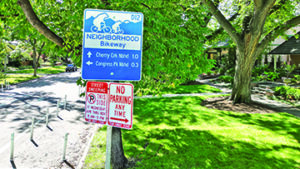
Sign incorrectly labels the distances to the Congress Park and Cherry Creek neighborhoods.
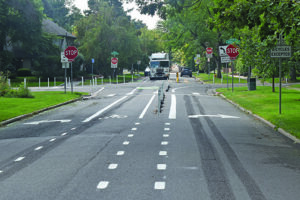
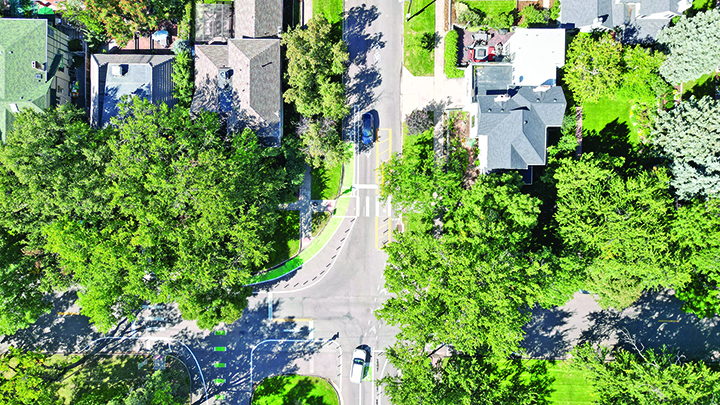
Automobile about to illegally take a right on Williams Street from 7th Avenue. The motorist was required to somehow know that it had to go on the right of the bollards 100 yards back.
The Recall Momentum
Many activists in Sawyer’s District 5 do not intend to let the dangerous situation go unaddressed. Sawyer was re-elected in the spring election over Michael Hughes on a campaign of championing street safety. One activist noted: “We can’t recall until six months from the time she began her second term, but we are drawing up the petitions and raising money for the fight. We have had enough of this crooked politician and her intentional endangerment of our kids and others.”
Until Then
Until Sawyer can be recalled, DOTI most likely will not do anything to make the situation any better. Residents note that accidents will inevitably happen at 7th and Williams and the roundabout come winter. Some other wonder out loud what type of horrific accident will have to occur for city officials to act.

by Charles Bonniwell | Jul 20, 2023 | Editorials
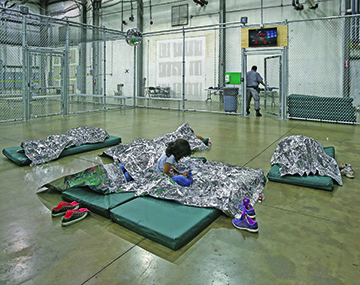

Mike Johnston is sworn in as the 46th Mayor of Denver on July 17, 2023.
Although the Biden Administration may dispute it, most people would view seven million people illegally crossing the United States southern border in the last several years as a financial disaster. That does not mean that there is not a lot of money to be made from it. Certainly, the Mexican drug cartel bringing fentanyl and other drugs, the coyotes smuggling in illegal immigrants, the nonprofit groups sheltering the immigrants once they cross, and the federal contracts paid to disburse them throughout the country; all are doing very well indeed.
Denver has absorbed only a small fraction of the recent immigrants with Denver officials estimating approximately 1,200 at any one time with the cost estimated to be up to $1,000 per immigrant per week (an estimated $17 million total). The immigrants have been housed in recreation centers and anywhere else space could be found.
The Hancock Administration in its final days wanted to burden the new Johnston administration with a one-year contract with GardaWorld Federal Services to operate a single 1,000-person shelter with intake services, food, and transportation for $40 million.
Denver’s nonprofit world went bonkers. They screamed about the city of Denver hiring a Canadian detention company with an awful record of waste and abuse when they could provide an equal amount of waste and abuse with money staying right here in Denver. Sometimes people fail to comprehend that “nonprofit” is simply a federal tax status and the people running them are every bit as rapacious and money hungry as their counterparts in the for-profit world.
At $40,000 per immigrant, per year, there is plenty of gravy to go around, especially considering that many more shelters will probably be needed and for an indefinite period of time. Moreover, the educational and health needs of every immigrant will also need to be provided.
Luckily, our new mayor Mike Johnston has indicted that he can solve all these problems, as well as the indigenous homeless quagmire, all in a single year with his tiny homes and other programs. Previous mayor, now Senator, John Hickenlooper had promised he would end homelessness in a decade, but later said that was just sales puffery for the always gullible Denver residents.
With Mike Johnston being sworn in on July 17, 2023, it is exciting to know that all these problems, some of which have plagued mankind since civilization began, will be solved in less than one year. In the meantime, don’t you be handing out any lucrative contracts. Keep the largesse right here in Denver, on the off chance that the problems might go on slightly past July 16th of 2024.
— Editorial Board















